Clinical Project on Preclusion and Management of Healthcare Infections
VerifiedAdded on 2023/06/03
|12
|1028
|51
Project
AI Summary
This clinical project focuses on the preclusion and management of healthcare-related infections, highlighting their significance in patient care and the preventability of common types such as urinary tract infections, surgical site infections, bloodstream infections, pneumonia, and Clostridium difficile. It details various methods for prevention and control, including proper hand hygiene, patient isolation, and adherence to standard precautions like glove use and transmission-based precautions. The project emphasizes strategies targeting specific nosocomial infections like ventilator-associated pneumonia (VAP), catheter-related bloodstream infections (CRBSI), and urinary tract infections (UTI). Furthermore, it underscores the importance of proper patient care in improving recovery and quality of life, referencing national health and safety standards designed to ensure quality health services. These standards cover areas such as infection prevention, patient communication, medication safety, fall prevention, patient identification, and clinical handover, all aimed at safeguarding patients and enhancing healthcare quality.
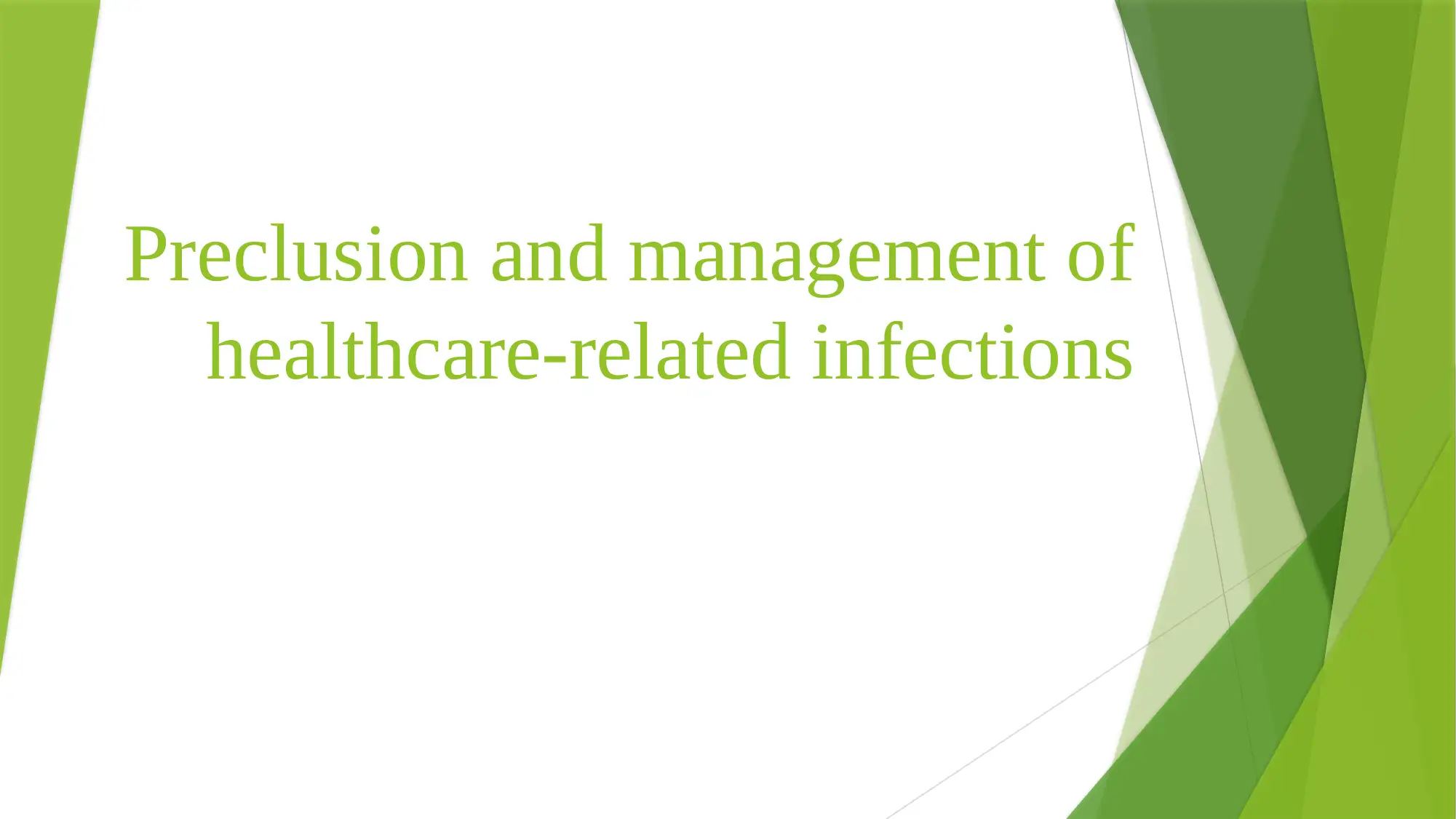
Preclusion and management of
healthcare-related infections
healthcare-related infections
Paraphrase This Document
Need a fresh take? Get an instant paraphrase of this document with our AI Paraphraser
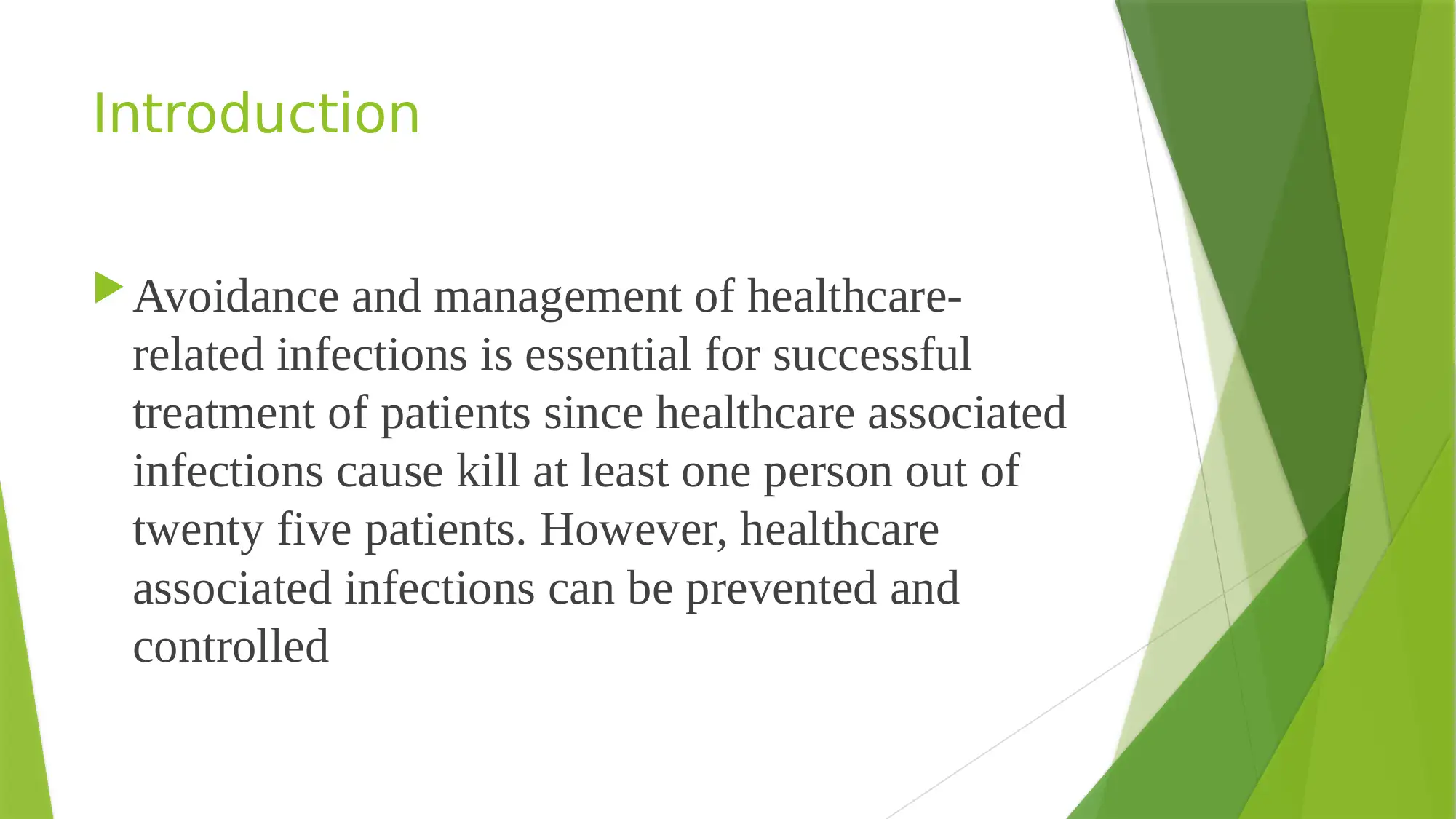
Introduction
Avoidance and management of healthcare-
related infections is essential for successful
treatment of patients since healthcare associated
infections cause kill at least one person out of
twenty five patients. However, healthcare
associated infections can be prevented and
controlled
Avoidance and management of healthcare-
related infections is essential for successful
treatment of patients since healthcare associated
infections cause kill at least one person out of
twenty five patients. However, healthcare
associated infections can be prevented and
controlled
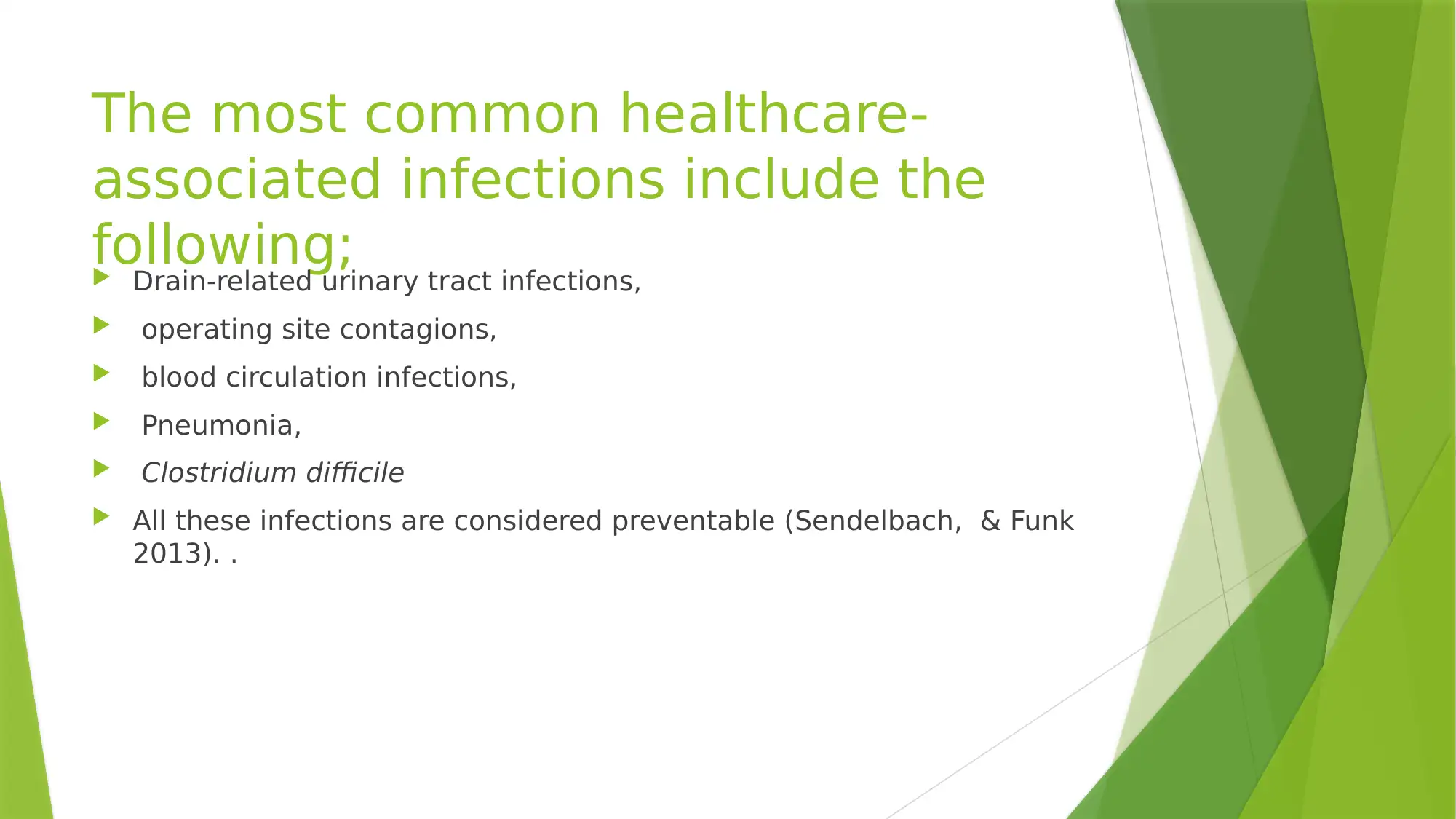
The most common healthcare-
associated infections include the
following; Drain-related urinary tract infections,
operating site contagions,
blood circulation infections,
Pneumonia,
Clostridium difficile
All these infections are considered preventable (Sendelbach, & Funk
2013). .
associated infections include the
following; Drain-related urinary tract infections,
operating site contagions,
blood circulation infections,
Pneumonia,
Clostridium difficile
All these infections are considered preventable (Sendelbach, & Funk
2013). .
⊘ This is a preview!⊘
Do you want full access?
Subscribe today to unlock all pages.

Trusted by 1+ million students worldwide

Methods of prevention and control
of healthcare associated infections.
There are several ways to prevent and control health
associated infections, they include;
proper hand hygiene. High hygiene standards should be
maintained to avoid transmission of infection to and from
the patient. (Vardi et al 2013)
Isolation of patients, For instance immunocompromised
patients should be isolated from others to avoid
opportunistic infections.
Correspondence and sympathy increment the level of trust
among patients and their parental figures, along these lines
enhancing their aggregate levels of fulfillment. Patients are
additionally more prone to cling to their treatment
suggestions when they are given more data and regard.
(Magrabi et al 2013).
of healthcare associated infections.
There are several ways to prevent and control health
associated infections, they include;
proper hand hygiene. High hygiene standards should be
maintained to avoid transmission of infection to and from
the patient. (Vardi et al 2013)
Isolation of patients, For instance immunocompromised
patients should be isolated from others to avoid
opportunistic infections.
Correspondence and sympathy increment the level of trust
among patients and their parental figures, along these lines
enhancing their aggregate levels of fulfillment. Patients are
additionally more prone to cling to their treatment
suggestions when they are given more data and regard.
(Magrabi et al 2013).
Paraphrase This Document
Need a fresh take? Get an instant paraphrase of this document with our AI Paraphraser
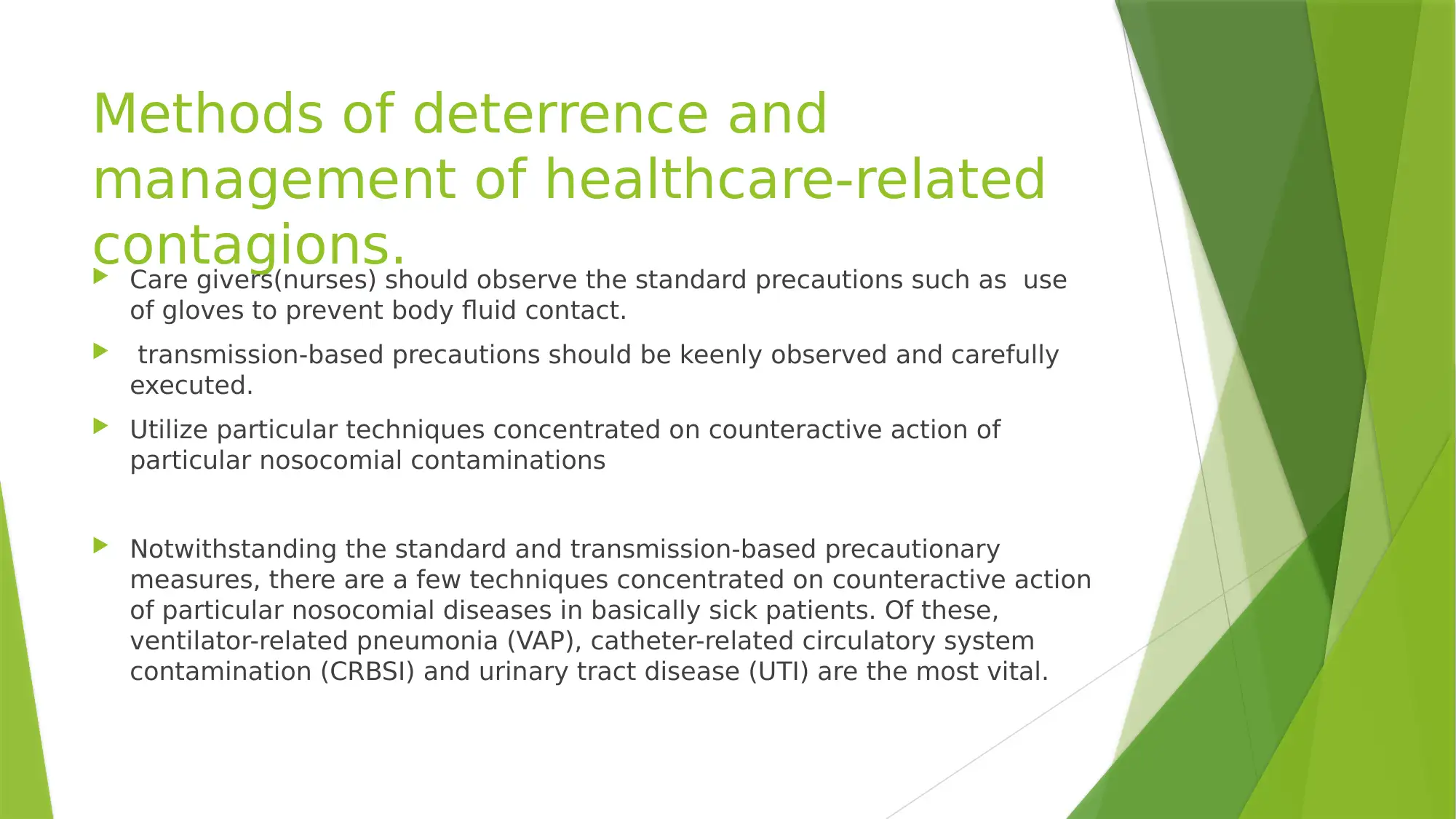
Methods of deterrence and
management of healthcare-related
contagions. Care givers(nurses) should observe the standard precautions such as use
of gloves to prevent body fluid contact.
transmission-based precautions should be keenly observed and carefully
executed.
Utilize particular techniques concentrated on counteractive action of
particular nosocomial contaminations
Notwithstanding the standard and transmission-based precautionary
measures, there are a few techniques concentrated on counteractive action
of particular nosocomial diseases in basically sick patients. Of these,
ventilator-related pneumonia (VAP), catheter-related circulatory system
contamination (CRBSI) and urinary tract disease (UTI) are the most vital.
management of healthcare-related
contagions. Care givers(nurses) should observe the standard precautions such as use
of gloves to prevent body fluid contact.
transmission-based precautions should be keenly observed and carefully
executed.
Utilize particular techniques concentrated on counteractive action of
particular nosocomial contaminations
Notwithstanding the standard and transmission-based precautionary
measures, there are a few techniques concentrated on counteractive action
of particular nosocomial diseases in basically sick patients. Of these,
ventilator-related pneumonia (VAP), catheter-related circulatory system
contamination (CRBSI) and urinary tract disease (UTI) are the most vital.
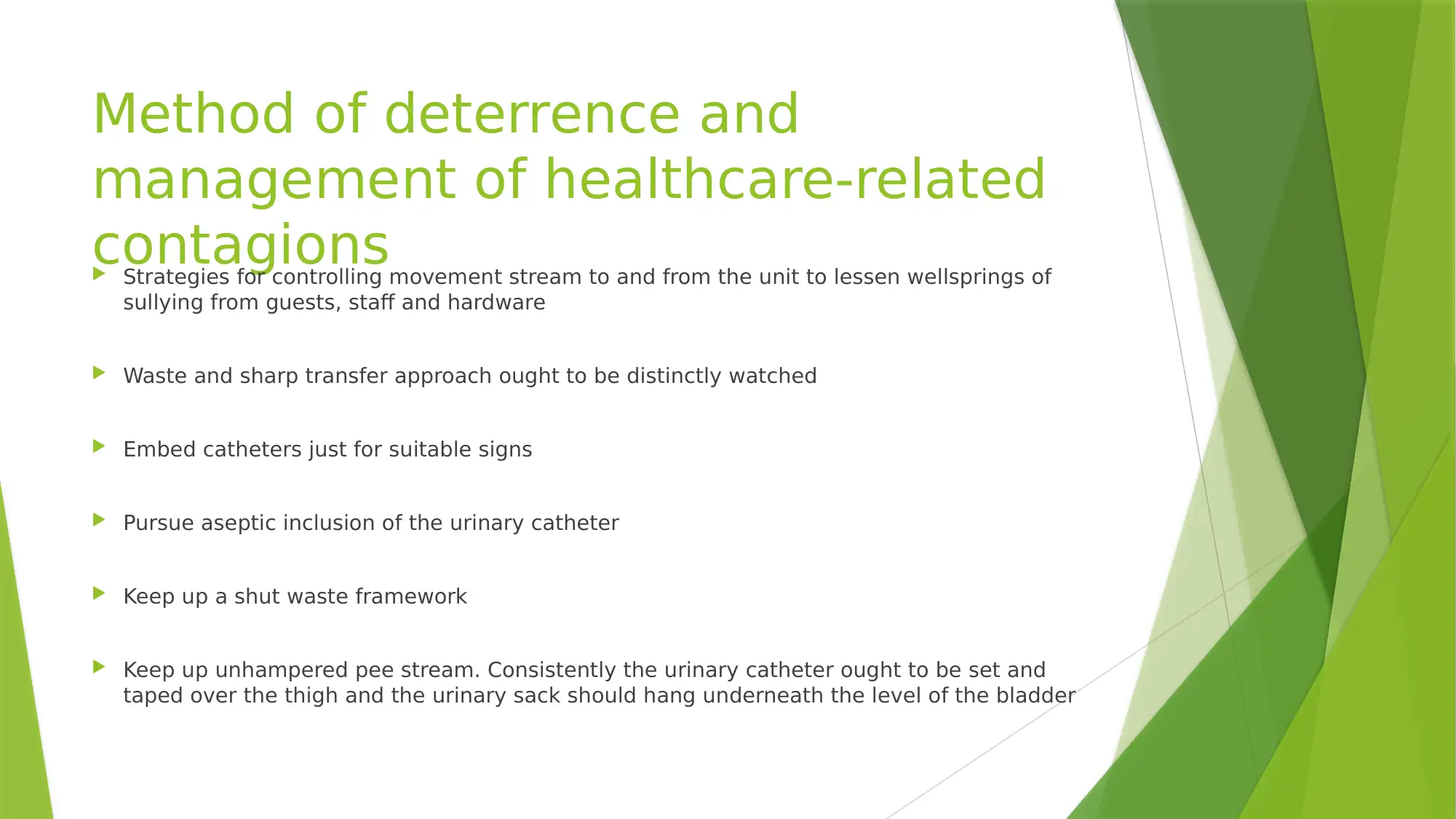
Method of deterrence and
management of healthcare-related
contagions Strategies for controlling movement stream to and from the unit to lessen wellsprings of
sullying from guests, staff and hardware
Waste and sharp transfer approach ought to be distinctly watched
Embed catheters just for suitable signs
Pursue aseptic inclusion of the urinary catheter
Keep up a shut waste framework
Keep up unhampered pee stream. Consistently the urinary catheter ought to be set and
taped over the thigh and the urinary sack should hang underneath the level of the bladder
management of healthcare-related
contagions Strategies for controlling movement stream to and from the unit to lessen wellsprings of
sullying from guests, staff and hardware
Waste and sharp transfer approach ought to be distinctly watched
Embed catheters just for suitable signs
Pursue aseptic inclusion of the urinary catheter
Keep up a shut waste framework
Keep up unhampered pee stream. Consistently the urinary catheter ought to be set and
taped over the thigh and the urinary sack should hang underneath the level of the bladder
⊘ This is a preview!⊘
Do you want full access?
Subscribe today to unlock all pages.

Trusted by 1+ million students worldwide
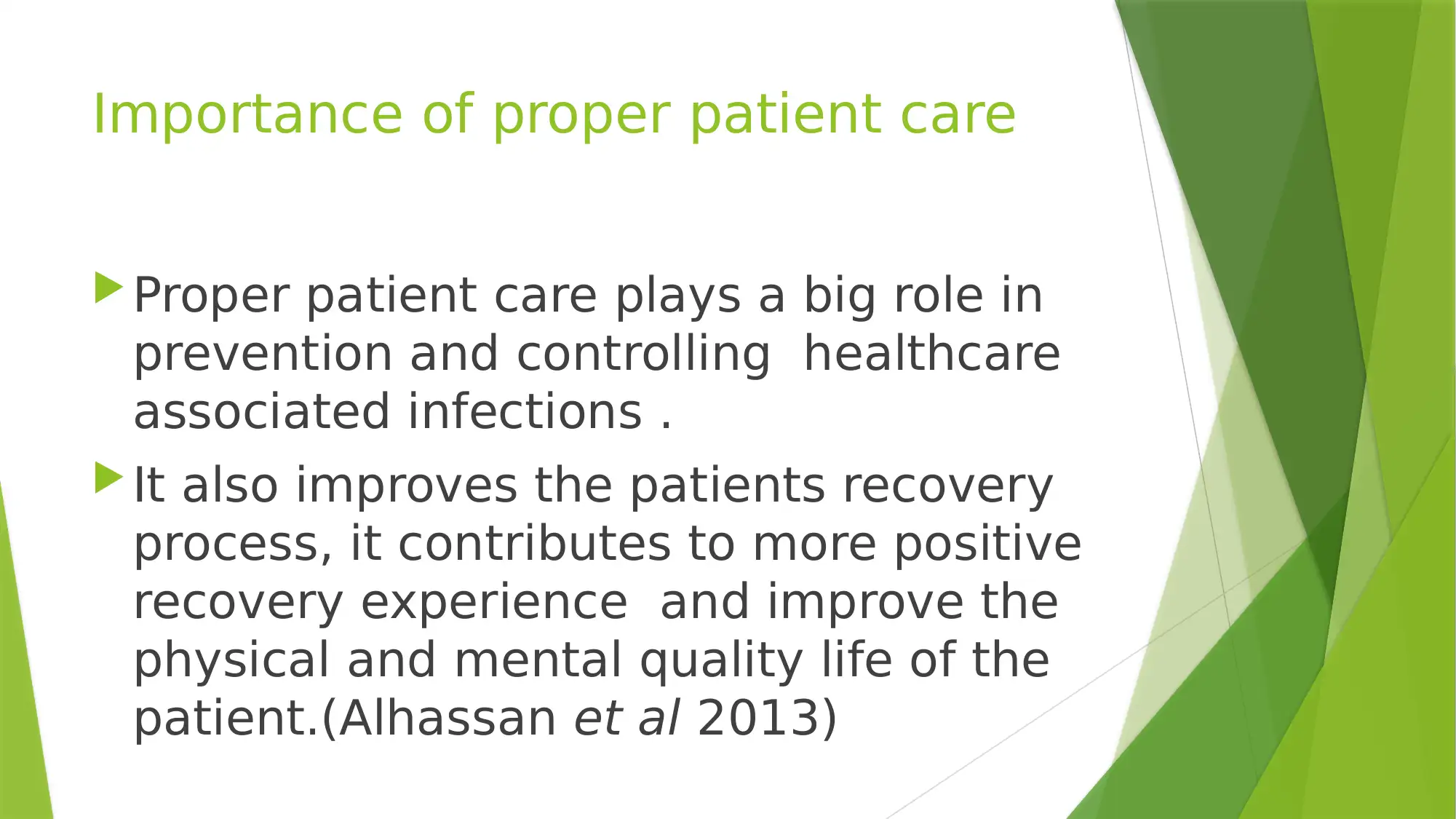
Importance of proper patient care
Proper patient care plays a big role in
prevention and controlling healthcare
associated infections .
It also improves the patients recovery
process, it contributes to more positive
recovery experience and improve the
physical and mental quality life of the
patient.(Alhassan et al 2013)
Proper patient care plays a big role in
prevention and controlling healthcare
associated infections .
It also improves the patients recovery
process, it contributes to more positive
recovery experience and improve the
physical and mental quality life of the
patient.(Alhassan et al 2013)
Paraphrase This Document
Need a fresh take? Get an instant paraphrase of this document with our AI Paraphraser
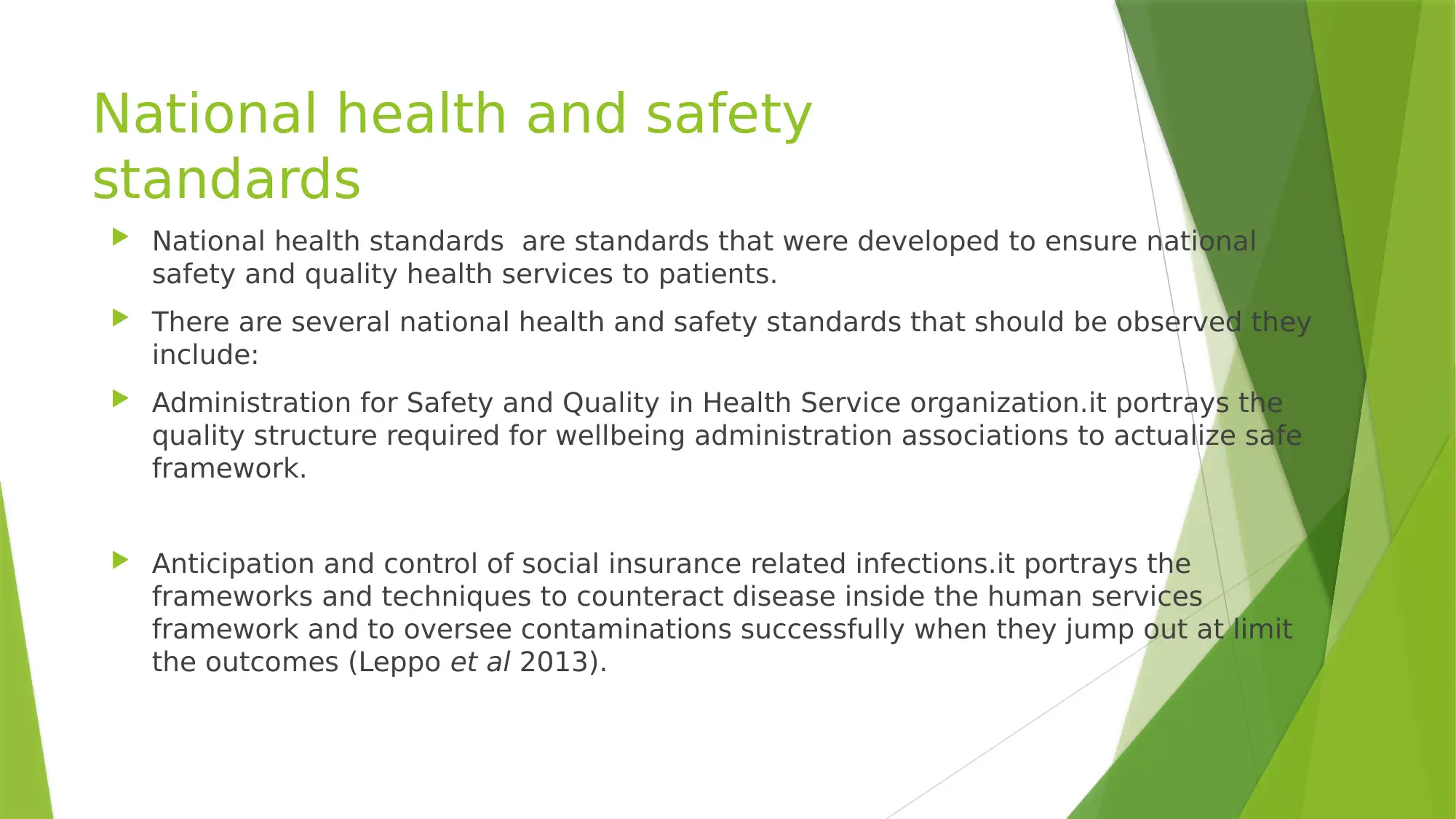
National health and safety
standards
National health standards are standards that were developed to ensure national
safety and quality health services to patients.
There are several national health and safety standards that should be observed they
include:
Administration for Safety and Quality in Health Service organization.it portrays the
quality structure required for wellbeing administration associations to actualize safe
framework.
Anticipation and control of social insurance related infections.it portrays the
frameworks and techniques to counteract disease inside the human services
framework and to oversee contaminations successfully when they jump out at limit
the outcomes (Leppo et al 2013).
standards
National health standards are standards that were developed to ensure national
safety and quality health services to patients.
There are several national health and safety standards that should be observed they
include:
Administration for Safety and Quality in Health Service organization.it portrays the
quality structure required for wellbeing administration associations to actualize safe
framework.
Anticipation and control of social insurance related infections.it portrays the
frameworks and techniques to counteract disease inside the human services
framework and to oversee contaminations successfully when they jump out at limit
the outcomes (Leppo et al 2013).
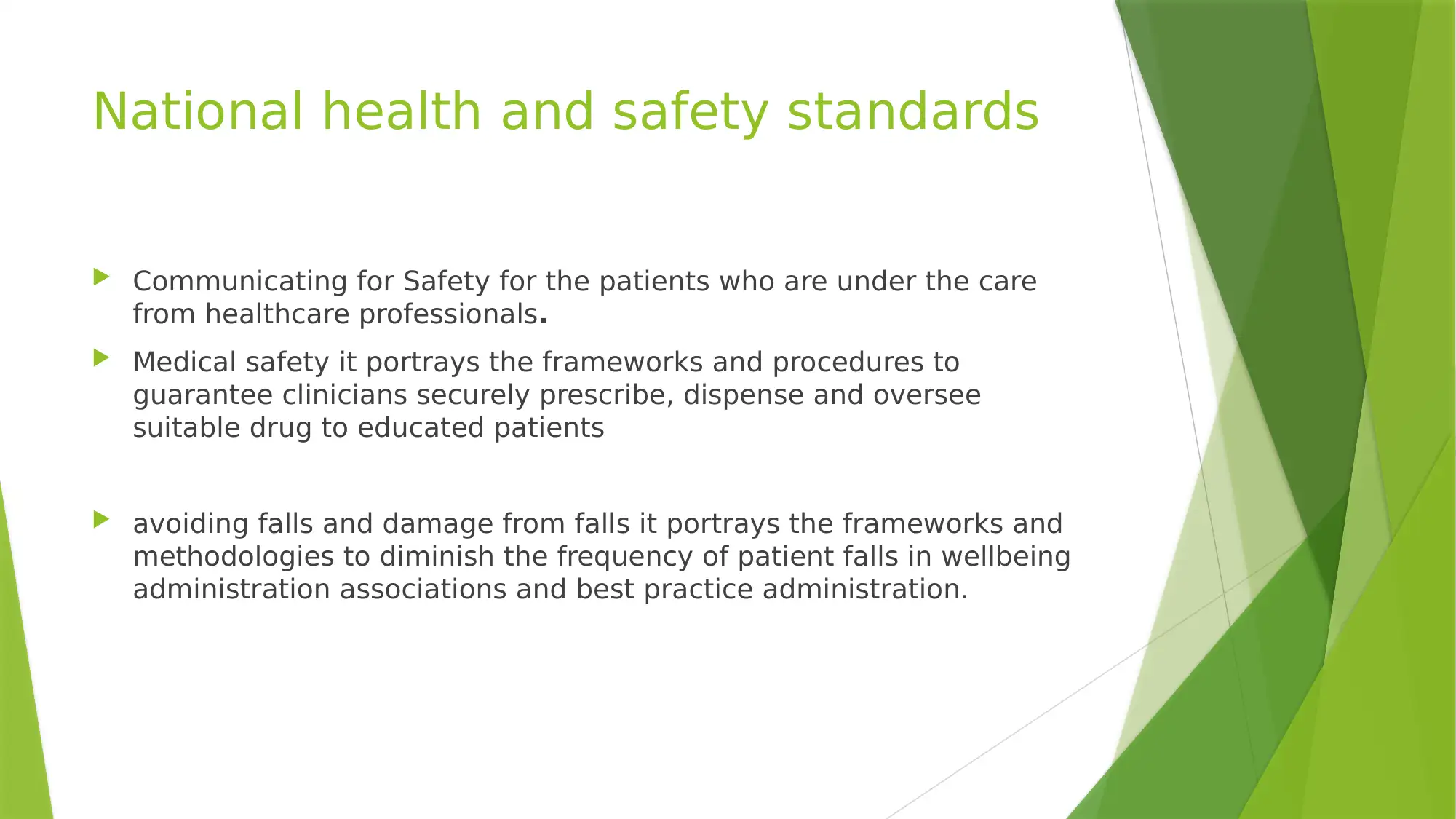
National health and safety standards
Communicating for Safety for the patients who are under the care
from healthcare professionals.
Medical safety it portrays the frameworks and procedures to
guarantee clinicians securely prescribe, dispense and oversee
suitable drug to educated patients
avoiding falls and damage from falls it portrays the frameworks and
methodologies to diminish the frequency of patient falls in wellbeing
administration associations and best practice administration.
Communicating for Safety for the patients who are under the care
from healthcare professionals.
Medical safety it portrays the frameworks and procedures to
guarantee clinicians securely prescribe, dispense and oversee
suitable drug to educated patients
avoiding falls and damage from falls it portrays the frameworks and
methodologies to diminish the frequency of patient falls in wellbeing
administration associations and best practice administration.
⊘ This is a preview!⊘
Do you want full access?
Subscribe today to unlock all pages.

Trusted by 1+ million students worldwide
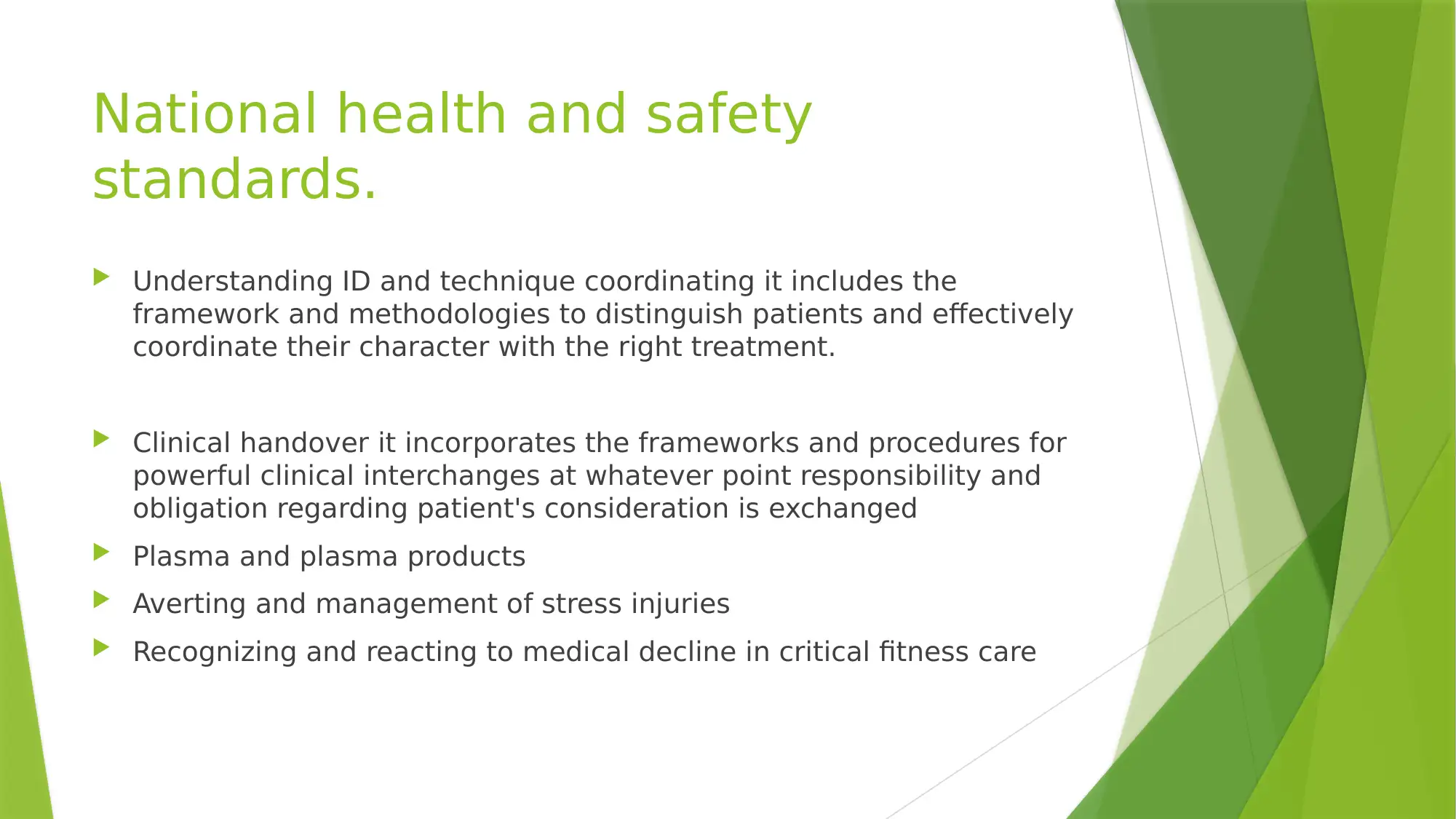
National health and safety
standards.
Understanding ID and technique coordinating it includes the
framework and methodologies to distinguish patients and effectively
coordinate their character with the right treatment.
Clinical handover it incorporates the frameworks and procedures for
powerful clinical interchanges at whatever point responsibility and
obligation regarding patient's consideration is exchanged
Plasma and plasma products
Averting and management of stress injuries
Recognizing and reacting to medical decline in critical fitness care
standards.
Understanding ID and technique coordinating it includes the
framework and methodologies to distinguish patients and effectively
coordinate their character with the right treatment.
Clinical handover it incorporates the frameworks and procedures for
powerful clinical interchanges at whatever point responsibility and
obligation regarding patient's consideration is exchanged
Plasma and plasma products
Averting and management of stress injuries
Recognizing and reacting to medical decline in critical fitness care
Paraphrase This Document
Need a fresh take? Get an instant paraphrase of this document with our AI Paraphraser
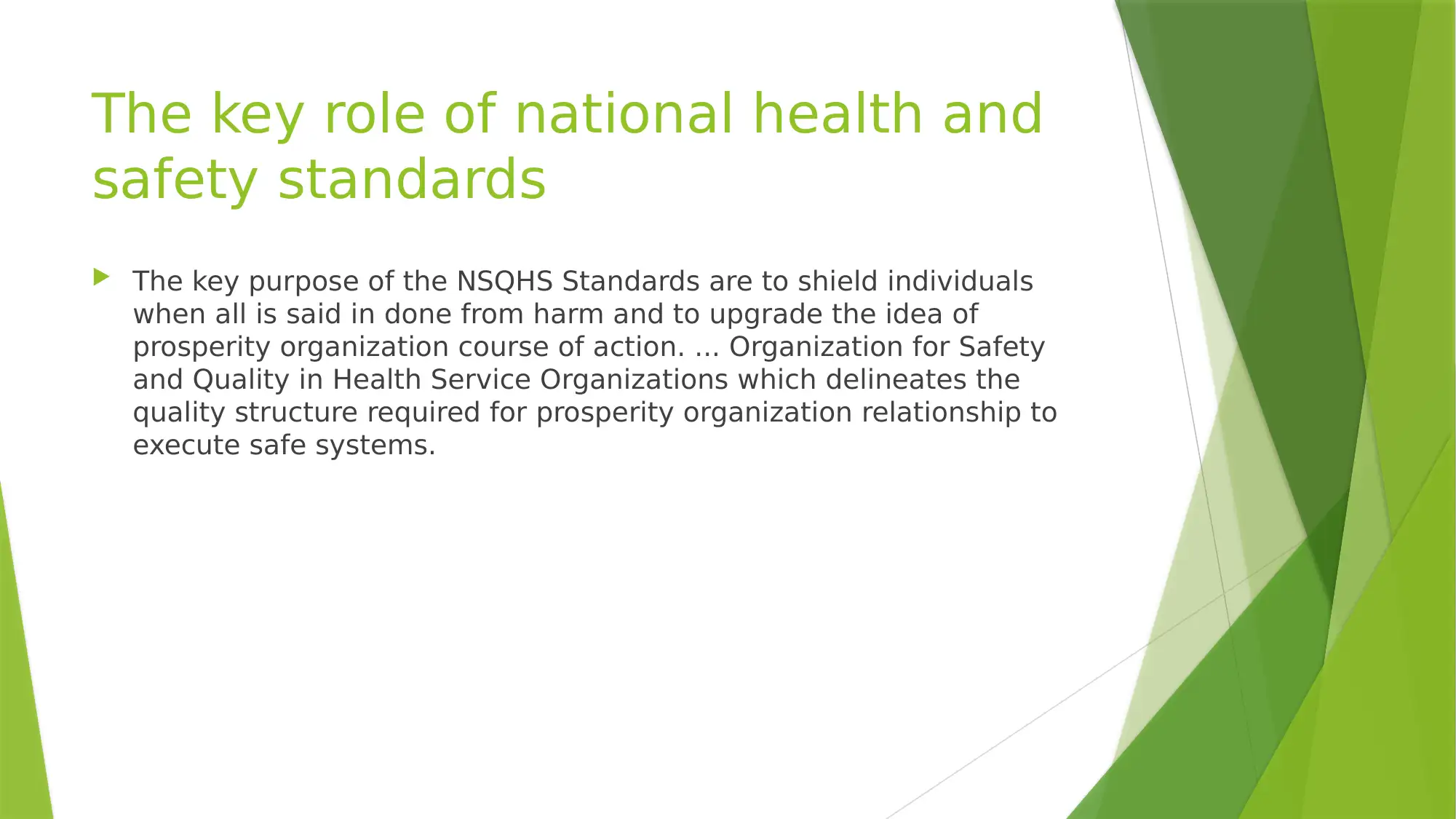
The key role of national health and
safety standards
The key purpose of the NSQHS Standards are to shield individuals
when all is said in done from harm and to upgrade the idea of
prosperity organization course of action. ... Organization for Safety
and Quality in Health Service Organizations which delineates the
quality structure required for prosperity organization relationship to
execute safe systems.
safety standards
The key purpose of the NSQHS Standards are to shield individuals
when all is said in done from harm and to upgrade the idea of
prosperity organization course of action. ... Organization for Safety
and Quality in Health Service Organizations which delineates the
quality structure required for prosperity organization relationship to
execute safe systems.
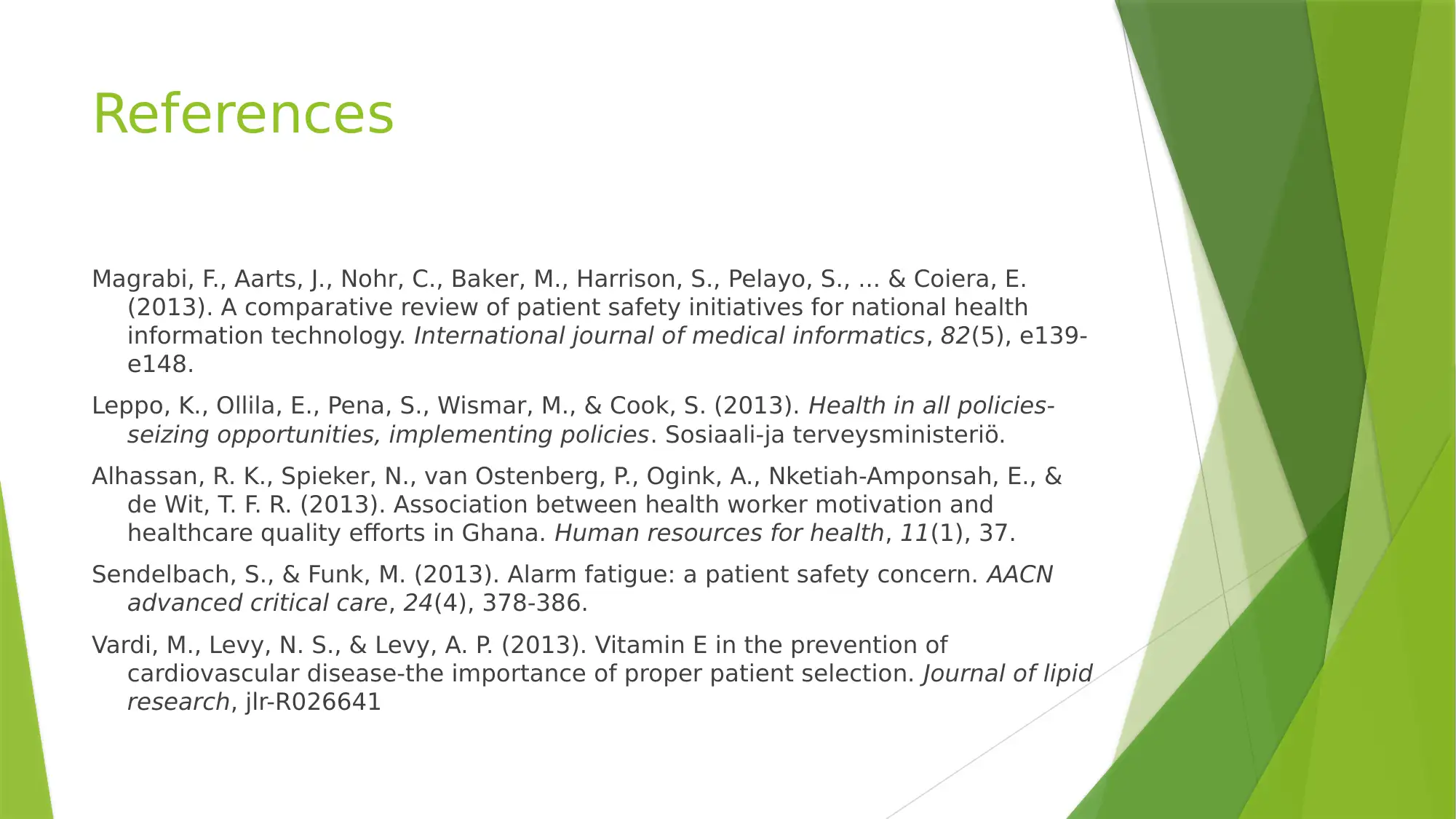
References
Magrabi, F., Aarts, J., Nohr, C., Baker, M., Harrison, S., Pelayo, S., ... & Coiera, E.
(2013). A comparative review of patient safety initiatives for national health
information technology. International journal of medical informatics, 82(5), e139-
e148.
Leppo, K., Ollila, E., Pena, S., Wismar, M., & Cook, S. (2013). Health in all policies-
seizing opportunities, implementing policies. Sosiaali-ja terveysministeriö.
Alhassan, R. K., Spieker, N., van Ostenberg, P., Ogink, A., Nketiah-Amponsah, E., &
de Wit, T. F. R. (2013). Association between health worker motivation and
healthcare quality efforts in Ghana. Human resources for health, 11(1), 37.
Sendelbach, S., & Funk, M. (2013). Alarm fatigue: a patient safety concern. AACN
advanced critical care, 24(4), 378-386.
Vardi, M., Levy, N. S., & Levy, A. P. (2013). Vitamin E in the prevention of
cardiovascular disease-the importance of proper patient selection. Journal of lipid
research, jlr-R026641
Magrabi, F., Aarts, J., Nohr, C., Baker, M., Harrison, S., Pelayo, S., ... & Coiera, E.
(2013). A comparative review of patient safety initiatives for national health
information technology. International journal of medical informatics, 82(5), e139-
e148.
Leppo, K., Ollila, E., Pena, S., Wismar, M., & Cook, S. (2013). Health in all policies-
seizing opportunities, implementing policies. Sosiaali-ja terveysministeriö.
Alhassan, R. K., Spieker, N., van Ostenberg, P., Ogink, A., Nketiah-Amponsah, E., &
de Wit, T. F. R. (2013). Association between health worker motivation and
healthcare quality efforts in Ghana. Human resources for health, 11(1), 37.
Sendelbach, S., & Funk, M. (2013). Alarm fatigue: a patient safety concern. AACN
advanced critical care, 24(4), 378-386.
Vardi, M., Levy, N. S., & Levy, A. P. (2013). Vitamin E in the prevention of
cardiovascular disease-the importance of proper patient selection. Journal of lipid
research, jlr-R026641
⊘ This is a preview!⊘
Do you want full access?
Subscribe today to unlock all pages.

Trusted by 1+ million students worldwide
1 out of 12
Related Documents
Your All-in-One AI-Powered Toolkit for Academic Success.
+13062052269
info@desklib.com
Available 24*7 on WhatsApp / Email
![[object Object]](/_next/static/media/star-bottom.7253800d.svg)
Unlock your academic potential
Copyright © 2020–2025 A2Z Services. All Rights Reserved. Developed and managed by ZUCOL.




